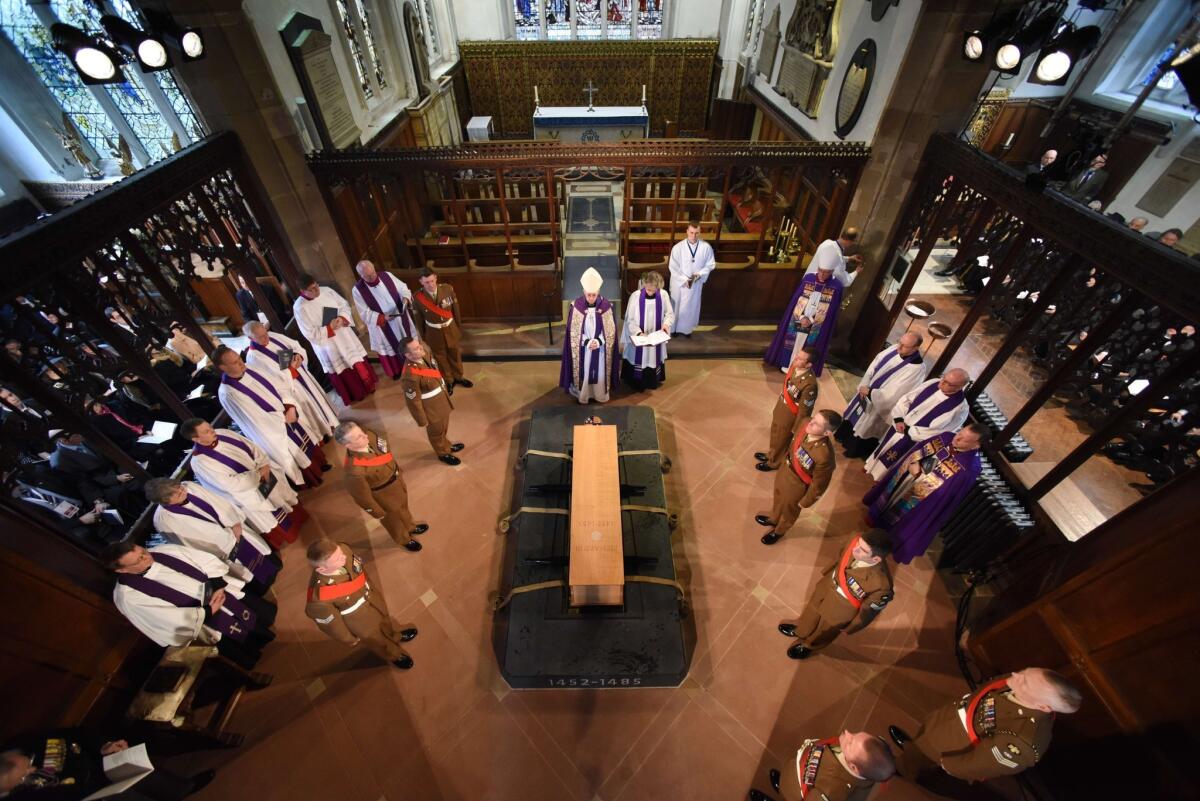Finally at rest: Britain’s King Richard III buried with pomp, poetry

A handout picture released by Leicester Cathedral Quarter Partnership Board shows the coffin of King Richard III in the tomb area during the reinterment ceremony in Leicester Cathedral on March 26.
- Share via
Reporting from Leicester, Englad — He will always be known as the king whose bones were discovered beneath a parking lot. But on Thursday, Richard III was given a send-off befitting his regal title.
In a ceremony oozing with British pomp and circumstance, and attended by royals, dignitaries and even a Hollywood star, the city of Leicester finally laid to rest the remains of the last Plantagenet king, 530 years after his death.
The hourlong ceremony marked the culmination of a week of celebration and reflection that many locals have rejoiced for putting Leicester, a city of 330,000 located 100 miles north of London, on the map.
It also went a long way to absolving the reputation of the much-maligned king who supporters feel has been wrongly depicted – not least in Shakespeare’s “Richard III” -- as an evil, power-hungry hunchback.
For his supporters, Thursday was a chance to set the history books right and finally give a man who was king of England for two years the recognition and farewell he deserved.
“I think it’s high time we put the last Plantagenet king to rest in a fitting way,” said Bill Boulter, chairman of Leicester’s City Council.
The congregation for the mid-morning sendoff included some well-known British actors who have played Richard III, among them Oscar-nominee Benedict Cumberbatch, who read a poem by Britain’s poet laureate, Carol Ann Duffy.
“Grant me the carving of my name,” he read, on the day that the king was finally put into a marked grave.
Cumberbatch depicts the king in a BBC series “The Hollow Crown,” and researchers say he is his second cousin 16 times removed.
The order of service was full of symbolism, with Bible readings, prayers, Latin psalms, plainsong and specially-composed music sung by Leicester Cathedral Choir.
In his eulogy, University of Leicester’s public orator Gordon Campbell described it as a “service of remembrance” and said Richard III had the greatest following of any monarch, except the current Queen Elizabeth II.
The sermon was delivered by the Bishop of Leicester, Tim Stevens, who said this tale of intrigue has “broken open not just a car park, but a nation’s story.”
About 200 seats were allocated to the public via ballots, and there were an abundance of women in hats and spectators elated to witness history in the making.
“It was absolutely amazing,” said 83-year-old Maureen Bonner, from Leicestershire. “It gave me a shiver up my spine. You feel that he’s at rest now, he’s at peace and he’s good.”
Britain’s 88-year-old queen, who has been on the throne more than six decades longer than Richard, was not present. She sent a message that was printed in the order of service in which she described the day as “an event of great national and international significance.”
The monarch’s daughter-in-law Sophie, Countess of Wessex, was present in the queen’s absence, clad head-to-toe in black.
She followed the coffin as it was carried by pallbearers to the tomb and lowered into the cathedral floor and sprinkled with earth gathered from places that symbolize Richard III’s life and death.
The festivities began in Leicester on Sunday when Richard III’s coffin was taken on a 22-mile journey around the surrounding countryside. The stops included Bosworth, where he was slain -- the last English king to die in battle – bringing his challenger, Henry Tudor, to the throne.
But these events were really the culmination of nearly three years of painstaking research and planning that began when the bones were first uncovered during an archaeological dig in a parking lot in 2012.
The hunt had been spearheaded by Philippa Langley of the Richard III Society and used old maps to find the long-demolished medieval priory where his body was hastily buried.
The skeleton had distinctive curvature of the spine, known as scoliosis, which was a defining characteristic of Richard III. Researchers also tracked down living relatives to prove their case using DNA, including that of cabinetmaker Richard Ibsen who is the 17th great-grandnephew of the former king.
The 58-year-old was bestowed the honor of creating a coffin for his ancestor, an undertaking that he admitted would often make him think: “This is a strange situation to find yourself in.”
Only the weather was beyond the organizers’ control. but that too seemed to mirror the sentiment of the day and move from overcast and somber to sunny and uplifting.
As the crowds filtered out of the cathedral, Langley walked around the exterior soaking up the occasion with a big smile.
She was barely able to walk three steps before being stopped by a new well-wisher praising her for her achievement.
“Today it does feel like it’s the cherry on the cake,” she said, explaining that she had seen many people with tears in their eyes during the service, but for her it felt like more of a celebration.
“Because we have achieved what we wanted to achieve,” she explained. “Richard is now at rest.”
Boyle is a special correspondent.
More to Read
Sign up for Essential California
The most important California stories and recommendations in your inbox every morning.
You may occasionally receive promotional content from the Los Angeles Times.













